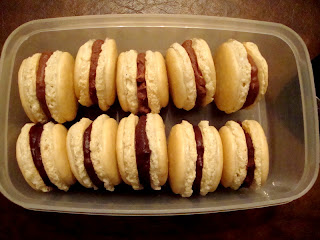Shoveling is far less glamorous than skiing, but for those of us living in colder climes, it is, alas, unavoidable! My coping strategy: reward yourself with good food and drink at the end of it. (No surprises there!) Of course, this isn't always possible: during Snowmageddon last winter, we lost power, so all we had to look forward to après-shoveling were a freezing house and cold sandwiches :(
We had our first shovel-worthy snow of the season today, so I resolutely dressed myself in my many layers of gear. Not before inspecting the contents of the fridge, however. It turned out I had a ramekin of clafoutis batter left over from last weekend's dessert, a poached pear clafoutis made to use up, in turn, one orphaned poached pear that I had left over from Thanksgiving. You see how useful it is to cook and bake regularly! Your fridge and pantry are a treasure-trove of supplies that make it easy to whip up something delicious in no time at all. So I dropped a handful of blueberries into the ramekin for good measure and stuck it in the oven. Armed with our cheerful new yellow shovel (last winter's excessive snow busted the old one), I ventured forth bravely outside.
The shoveling wasn't crazy, thankfully, and the newly-acquired Blizzard Wizard seems to be doing its job as well. (That is, after I wrestled the 50-lb bag from the most inaccessible corner of the garage). So all that was left to do was take a hot shower, fix myself some hot chocolate, and dig in to my treat! I normally make hot cocoa, which is a very guilt-free way to enjoy this winter essential, but since I'd officially had two workouts (gym + shoveling) I decided to make real hot chocolate, and add some whiskey to make it even more indulgent. Besides, two squares of chocolate were sitting forlornly in the pantry, and calling my name. Still, I don't like it excessively rich: I prefer to use 2% milk instead of cream. I also drink it unsweetened but you can add sugar to taste.
I don't know if winter will ever be my favorite season, but clearly, it's not without its advantages!
Recipe: Whiskey-spiked hot chocolate (Serves 1)
3/4 cup milk (I use 2% but you can use whole milk, cream or half-and-half)
1 oz. bittersweet chocolate, broken or chopped
1 1/2 tbsp whiskey, or any other spirit of choice (optional)
Brown sugar to taste (optional)
Place the whiskey, if using, in a mug. Heat the milk over medium heat in a small saucepan until steaming. Stir in the chocolate and whisk continuously until melted. Cook for another minute (or more if you want it thicker) and pour into the mug. Add sugar to taste, stir and enjoy!



























